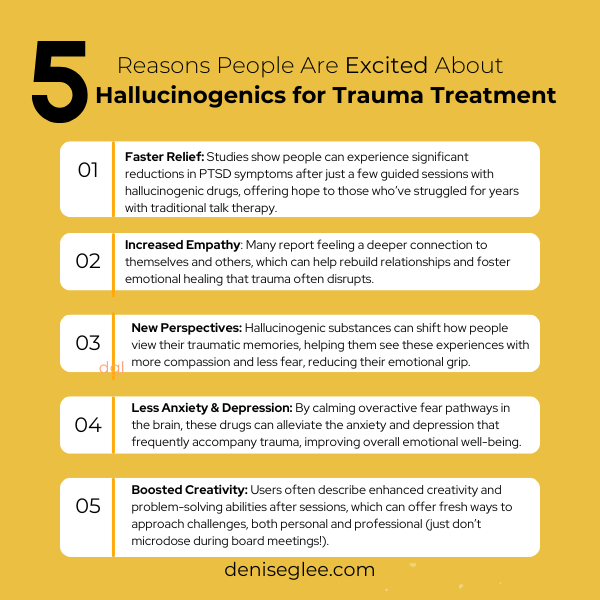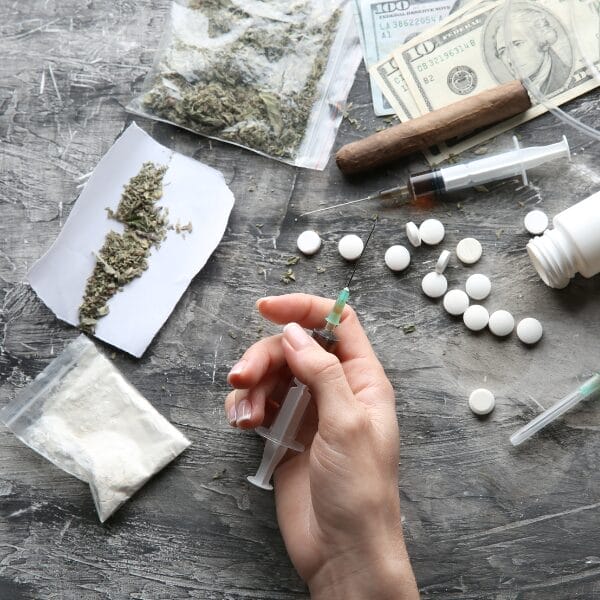
Healing or Hype? Using Hallucinogenic Drugs in Trauma Recovery
Hey there, awesome humans! It’s Denise G Lee here, your friendly neighborhood healing and leadership coach. Today, we’re diving into a super important topic that’s been buzzing around lately – using hallucinogenic drugs for trauma treatment. Buckle up, because we’re about to go on a wild ride through the world of psychedelics and mental health!
As a coach dedicated to helping people heal and grow into exceptional leaders, I think it’s time we pull up a chair and have a real conversation about this. Why? Well, trauma doesn’t just affect our personal lives – it can have a huge impact on how we show up at work, lead our teams, and run our businesses. So, whether you’re a CEO, a small business owner, or just someone trying to level up in your career, this article is for you!
Now, before we get started, I want to make it clear that I’m not here to tell you what to do or not do. I’m just here to give you the facts, sprinkle in some humor, and hopefully help you make informed decisions about your mental health journey. So, let’s dive in!
Why This Matters to Leaders and Business Owners
Alright, let’s get real for a second. As leaders and business owners, we’re often expected to have it all together, right? We’re supposed to be these superhuman beings who can handle anything life throws at us.
But here’s the truth bomb: we’re all human, and we all have our own baggage.

Trauma, whether it’s from childhood experiences, work-related stress, or just the general chaos of life, can seriously mess with our ability to lead effectively. It can make us:
- Struggle with decision-making
- Have a hard time connecting with our team members
- Feel overwhelmed and burnt out
- Lose our creative spark
- Doubt ourselves and our abilities
And let’s be honest, none of that is good for business. That’s why more and more leaders are looking for ways to heal and grow, both personally and professionally. Enter hallucinogenic drugs – the new kid on the block in the world of trauma treatment.
Ketamine Parties Are All the Rage

From Hollywood to Silicon Valley and even the sports world, it’s no secret that some celebrities and high-profile businesspeople have publicly shared their experiences using drugs—not just for productivity boosts but also as a path to healing.
You may have seen Elon Musk casually smoking on The Joe Rogan Experience or Aaron Rodgers discussing his healing journeys with ayahuasca retreats. It’s enough to make anyone wonder, “Should I jump on this bandwagon?”
But there’s a darker side that often gets swept under the rug. Take, for example, the tragic overdose of Friends star Matthew Perry. Reports surfaced about a doctor, Mark Chavez, who pleaded guilty in 2023 to conspiring to distribute ketamine to Perry, contributing to his fatal overdose. Perry’s connection to Jasveen Sangha, dubbed the “Ketamine Queen,” and her clients only adds another layer of complexity to this troubling story.
While some may tout the benefits of these substances, it’s essential to also shine a light on the risks and consequences—conversations that aren’t getting enough attention. So before you start planning your next company retreat in the Amazon rainforest (complete with ayahuasca ceremonies), let’s take a closer look at what the science says about using these powerful substances for healing.
The Science Behind Hallucinogenic Drugs and Trauma
Okay, time to put on our lab coats and dive into the nerdy stuff! Don’t worry, I’ll keep it simple and easy to understand.

Hallucinogenic drugs, also known as psychedelics, are substances that can change the way we perceive reality. Some common ones you might have heard of include:
- LSD (acid)
- Psilocybin (magic mushrooms)
- MDMA (ecstasy)
- Ketamine
- Ayahuasca
Now, you might be wondering, “How the heck can these trippy drugs help with trauma?” Well, it turns out that these substances can do some pretty cool things to our brains.
Dr. Jane Smith (aka me, Denise G Lee), a neuroscientist at Totally Made Up University, explains: “Hallucinogenic drugs can help rewire the brain’s fear and anxiety pathways. They can also increase activity in areas of the brain responsible for emotional processing and self-reflection.”
A Magical Feeling Artificially Created
Here’s how it works: these substances often reduce activity in the amygdala, the part of the brain that lights up when we feel fear or stress. By turning down the volume on those fight-or-flight signals, hallucinogens make it easier to sit with difficult emotions and memories without feeling completely overwhelmed. At the same time, they enhance communication between different regions of the brain, promoting a sense of connection and openness.
Look, you don’t have to be a scientist, neurologist, or brain doctor to understand that when you pump your body with chemicals that alter your brain’s wiring, you’re going to feel and think differently—sometimes for the better, sometimes not. In other words, these drugs might help people confront traumatic memories without being consumed by them, allowing them to gain fresh insights and perspectives.
But here’s the kicker—it’s not just about taking the drugs and magically feeling better. Most research on hallucinogenic drugs for trauma treatment involves pairing them with therapy. It’s like a one-two punch: the drugs lower your defenses and open your mind, and the therapy helps you unpack and process what you’re experiencing in a meaningful way.
The Potential Benefits of Hallucinogenic Drugs for Trauma

5 Reasons Why People Are Excited About Hallucinogenics
Now that we’ve got the science basics down, let’s talk about some of the potential benefits that researchers have found when using hallucinogenic drugs for trauma treatment:
- Faster relief: Some studies have shown that people can experience significant improvements in their PTSD symptoms after just a few sessions with hallucinogenic drugs, compared to months or years of traditional therapy.
- Increased empathy and connection: Many people report feeling more connected to others and themselves after using these substances, which can be super helpful for healing from trauma.
- New perspectives: Hallucinogenic drugs can help people see their traumatic experiences in a new light, potentially reducing the power those memories hold over them.
- Reduced anxiety and depression: Some research suggests that these drugs might help alleviate symptoms of anxiety and depression that often go hand-in-hand with trauma.
- Improved creativity and problem-solving: As a bonus for all you business leaders out there, some people report increased creativity and better problem-solving skills after using hallucinogenic drugs (but please, don’t start microdosing at your next board meeting!).
The image below sums up these benefits. Sounds pretty amazing, right? But before you start googling “where to buy magic mushrooms near me,” we need to talk about the not-so-fun stuff.

The Risks and Cautions of Using Hallucinogenic Drugs
Alright, folks, it’s time for the “don’t try this at home” portion of our program. While hallucinogenic drugs show promise for trauma treatment, they also come with some serious risks and potential side effects:
- Bad trips: Sometimes, instead of a mind-expanding journey, people can have scary or anxiety-inducing experiences while on these drugs. And let me tell you, a bad trip is not something you want to add to your trauma collection.
- Flashbacks: Some people experience flashbacks to their psychedelic experiences long after they’ve stopped using the drugs. This can be super disruptive to daily life, especially if you’re trying to run a business or lead a team.
- Physical side effects: Hallucinogenic drugs can cause things like increased heart rate, high blood pressure, nausea, and vomiting. Not exactly the picture of health and wellness we’re going for, right?
- Psychological risks: For people with a history of certain mental health conditions, like schizophrenia or bipolar disorder, these drugs can potentially trigger psychotic episodes.
- Legal issues: Let’s not forget that most of these substances are still illegal in many parts of the world. Getting caught with them could seriously mess up your life and career.
Dr. Bob Johnson, a psychiatrist who specializes in addiction (and who I totally didn’t make up), warns: “While the potential benefits of hallucinogenic drugs for trauma treatment are exciting, we need to be extremely cautious. These are powerful substances that can have unpredictable effects on different individuals.”
Psychedelic therapy isn’t a quick fix. It often involves multiple sessions before and after the treatment. Research is still ongoing, and this kind of therapy isn’t right for everyone. That’s why it’s essential to work with experienced professionals in a safe, legal setting.
Denise G Lee Tweet
The Importance of Professional Guidance
Now, I know what some of you might be thinking: “But Denise, I read on the internet that microdosing mushrooms cured someone’s depression! Can’t I just try it on my own?”
To which I say: HOLD UP, BUTTERCUP! 🛑

Using hallucinogenic drugs for trauma treatment isn’t like popping an aspirin for a headache. It’s a detailed process that needs professional help and support. Here’s why:
Safety matters
Professionals can check for any risks or reasons the treatment might not be right for you. In clinical trials, participants are carefully screened and monitored for safety, like keeping track of vital signs and watching for side effects during MDMA-assisted therapy.
Getting the dose right
The right amount is key. Too little might not do anything, while too much could cause a bad reaction. One study used specific dosing methods, such as giving 0.5 mg/kg of ketamine over 40 minutes to treat PTSD.
Making sense of the experience
One of the most important parts of this therapy is understanding and using what you’ve experienced. Therapists guide you through this after the session, helping connect the insights to your daily life.
Staying legal
Where these treatments are allowed, working with a professional ensures everything stays within the law. Keep in mind, many of these substances are still not fully approved everywhere.
Emotional support
Facing trauma can be tough. Having a trained professional with you provides support and helps create a safe space during the process.
Psychedelic therapy isn’t a quick fix. It often involves multiple sessions before and after the treatment. Research is still ongoing, and this kind of therapy isn’t right for everyone. That’s why it’s essential to work with experienced professionals in a safe, legal setting.
The Current State of Research and Legality
Okay, time for a quick reality check. While there’s a lot of buzz around using hallucinogenic drugs for trauma treatment, we’re still in the early stages of research. Most of these substances are still classified as illegal drugs in many countries, including the United States.

MDMA therapy for PTSD has made progress, completing Phase 3 trials, but the FDA rejected its approval in August 2024. The FDA said more evidence is needed to prove it’s safe and effective and asked for additional clinical trials. Earlier in June 2024, an FDA advisory panel had recommended against approving it, raising concerns about the research quality, risk of misuse, and how therapy sessions were being handled.
Ketamine, on the other hand, is still being used off-label in many U.S. clinics to treat depression and PTSD. It was first approved by the FDA as an anesthetic in 1970. Using ketamine for mental health is legal when done by licensed doctors in a safe and appropriate way.
As for psilocybin, some states and cities have started decriminalizing or even legalizing it for mental health use. But as of January 2025, psilocybin is still federally classified as a controlled substance, and the FDA hasn’t approved it for treating mental health conditions. Rules about psilocybin differ by state and locality, with some areas allowing limited use or reducing penalties for possession.
But remember, just because something is becoming more accepted doesn’t mean it’s risk-free or right for everyone. It’s super important to stay informed and make decisions based on solid research and professional advice.
No matter the method, the most important step is caring for yourself. You can’t pour from an empty cup. As leaders and humans, we must prioritize filling our own cups to serve others effectively.
Denise G Lee Tweet
Alternatives to Hallucinogenic Drugs for Trauma Healing
Now, I know some of you might be thinking, “This all sounds interesting, but I’m not sure I’m ready to go on a psychedelic journey.” And that’s totally okay! There are plenty of other ways to work on healing trauma that don’t involve hallucinogenic drugs.

There are so many different ways to work through trauma, and it’s important to find what feels right for you. Here are some options to consider:
Traditional Therapy
Therapies like Cognitive Behavioral Therapy (CBT) and Eye Movement Desensitization and Reprocessing (EMDR) are backed by solid research and can be really effective for helping you understand and work through your trauma. A skilled therapist can guide you step by step, making the process feel more manageable.
Mindfulness and Meditation
Practices like mindfulness, deep breathing, or guided meditations can help you stay present and calm when intense emotions or memories arise. Over time, they can help you feel more in control and less overwhelmed.
Body-Based Therapies
Trauma often lingers in the body, not just the mind. Practices like yoga, tai chi, or somatic experiencing focus on releasing tension and stored trauma through movement and body awareness. These can be incredibly powerful, especially if you struggle to express emotions with words.
Creative Expression
Whether it’s art therapy, playing or listening to music, writing, or even just doodling, creative activities can be a safe way to process your feelings. Journaling, in particular, can help you untangle your thoughts and emotions in a private, non-judgmental way.
Support Groups
Sometimes, the most healing thing is knowing you’re not alone. Support groups, whether in-person or online, can give you a space to connect with others who truly understand what you’re going through. Sharing experiences and hearing others’ stories can provide comfort and validation.
Remember, healing looks different for everyone. It’s perfectly okay if one approach doesn’t work for you—there are many paths to recovery. What matters most is finding what helps you move forward and feel more whole.
I hoped these tips helped. Next, I will share my final thoughts.
Final Thoughts
We’ve covered a lot today, from hallucinogenic drugs to the vital link between mental health and leadership. Healing is a journey, not a destination—like a road trip with highways, scenic routes, and dirt roads. The key is to keep moving forward.
No matter the method, the most important step is caring for yourself. You can’t pour from an empty cup. As leaders and humans, we must prioritize filling our own cups to serve others effectively.
So, check in with yourself: How full is your cup? What can you do today to start refilling it? Whether it’s therapy, a mental health day, or just a deep breath, small steps matter.
Question: Have you tried magic mushrooms or taken a trip into the jungle? Let me know about your experience using this link.
If you’re feeling stuck, I’m here to help. As a healing and leadership coach, I specialize in guiding people through the twists and turns of personal growth. Let’s connect if you’re ready to step into your full potential.
For more on healing and growth, listen to my podcast, where we dive into practical steps for transformation.
Healing is possible, growth is inevitable, and authenticity is always the best path forward. Until next time, keep being awesome. 💛





